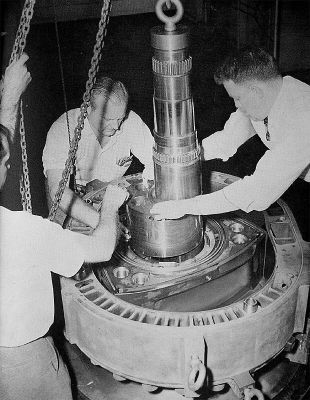rotary powerd train????
#2
2 minutes of searching Google came up with this...dunno if it's what your looking for....
bottom of 3rd paragraph mentions quasiturbine rotary steam engine:
http://solarsteamtrain.com/cms/content/view/13/28/
From there found this:
http://auto.howstuffworks.com/quasiturbine.htm
Then this:
http://www.dself.dsl.pipex.com/MUSEU...s/cochrane.htm
Hope that helps????
Cam...
bottom of 3rd paragraph mentions quasiturbine rotary steam engine:
http://solarsteamtrain.com/cms/content/view/13/28/
From there found this:
http://auto.howstuffworks.com/quasiturbine.htm
Then this:
http://www.dself.dsl.pipex.com/MUSEU...s/cochrane.htm
Hope that helps????
Cam...
Trending Topics
#10
dunno much about its use in a train,,
i believe it was a stationary engine that clocked up 40 000 hrs run time
( 4.5 years of continous running )
-equiv to a million Km
i believe it was a stationary engine that clocked up 40 000 hrs run time
( 4.5 years of continous running )
-equiv to a million Km
As early as 1960 pioneer Curtiss-Wright (C-W) had built a 31.5-liter (1920 ci) single-rotor engine intended to put out 1000 hp, but detonation problems prevented it from producing much more than 750 hp. C-W had seemingly discovered the Wankel equivalent of a fairly well-known problem with large high-speed piston engines. Generally, in such engines, above a bore size of about 100 mm (about 4 in) combustion cannot take place fast enough at higher engine speeds. Weight and cooling also become problems. Absolute limits hit at about 150 mm (6 in). Obviously, engines with larger bores exist in applications such as ships, but they are limited to very low engine speeds.
For the rotary, stratifying or layering the fuel-air mixture is one answer. But Ingersoll-Rand (I-R) licked this issue by designing its rotary--originally derived from Curtiss-Wright--to burn natural gas, applying lessons learned from gas turbine operation, and limiting the engine speed to 1200 rpm. The first I-R rotary began service in June 1975, a year before formal announcement of the program. By 1978 I-R had logged 100,000 hours of field operating time. The engine was available in 1- and 2-rotor versions rated at 550 and 1100 hp; it had a continuous 1000-rpm rating. The basic design including the cooling system was roughly comparable to automotive Mazda rotaries before 1974, except that the rotor housings were cast iron instead of aluminum. The rotor radius (-prime) x eccentricity x width (R' x e x B) were 16.700" x 2.400" x 12.00" (424.18 x 60.96 x 304.8 mm), giving a displacement per rotor of 2499 ci (41.0 liters). A person could easily crawl through an empty rotor housing!
I-R's publicity stressed the rotary's fuel economy (brake specific fuel consumption) in BTU/hp-hr in the normal compressor package compared to gas turbines and piston engines: at the time just around 9000 vs. 10%-30+% more for competitors. The company offered users a comprehensive service and maintenance package including change outs as needed, though the expected lifetime of the rotary power module was at least 8,000 hours. I-R was aiming for a lifetime of 24,000+ hours! Correspondence in 1982 put the cost of a complete compressor drive at $400 per rated horsepower and a maintenance contract including change outs of $5-$6 per operating hour. However, I-R ended rotary production by 1986. My written correspondence to the company in 1997 asking about the program went unanswered.
For the rotary, stratifying or layering the fuel-air mixture is one answer. But Ingersoll-Rand (I-R) licked this issue by designing its rotary--originally derived from Curtiss-Wright--to burn natural gas, applying lessons learned from gas turbine operation, and limiting the engine speed to 1200 rpm. The first I-R rotary began service in June 1975, a year before formal announcement of the program. By 1978 I-R had logged 100,000 hours of field operating time. The engine was available in 1- and 2-rotor versions rated at 550 and 1100 hp; it had a continuous 1000-rpm rating. The basic design including the cooling system was roughly comparable to automotive Mazda rotaries before 1974, except that the rotor housings were cast iron instead of aluminum. The rotor radius (-prime) x eccentricity x width (R' x e x B) were 16.700" x 2.400" x 12.00" (424.18 x 60.96 x 304.8 mm), giving a displacement per rotor of 2499 ci (41.0 liters). A person could easily crawl through an empty rotor housing!
I-R's publicity stressed the rotary's fuel economy (brake specific fuel consumption) in BTU/hp-hr in the normal compressor package compared to gas turbines and piston engines: at the time just around 9000 vs. 10%-30+% more for competitors. The company offered users a comprehensive service and maintenance package including change outs as needed, though the expected lifetime of the rotary power module was at least 8,000 hours. I-R was aiming for a lifetime of 24,000+ hours! Correspondence in 1982 put the cost of a complete compressor drive at $400 per rated horsepower and a maintenance contract including change outs of $5-$6 per operating hour. However, I-R ended rotary production by 1986. My written correspondence to the company in 1997 asking about the program went unanswered.
101 units had been built for gas compression and power generation. Production of new engines had ended before 1985, but production of replacement modules for field support continued through then
Thread
Thread Starter
Forum
Replies
Last Post
datfast1
Old School and Other Rotary
18
06-20-19 11:53 PM
rx8volks
Canadian Forum
0
09-01-15 11:46 PM
biggest, compressor, curtiss, displacement, engine, gas, huge, ingersoll, ingersollrand, largest, photograph, rand, rotary, rotor, score, wankel, wright






